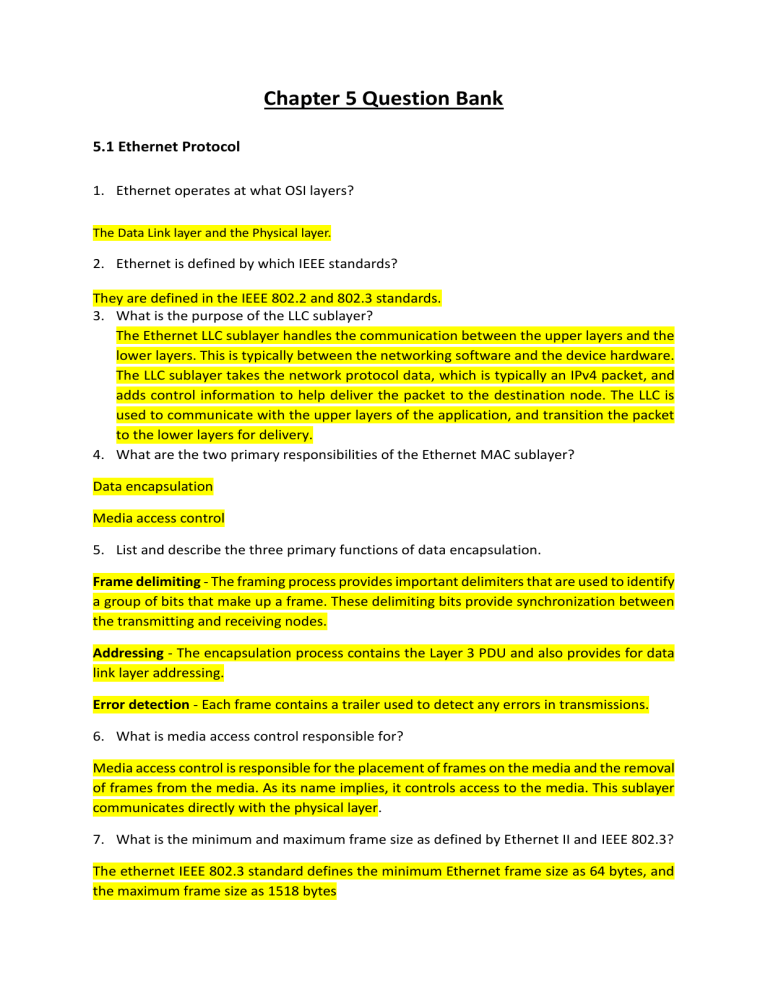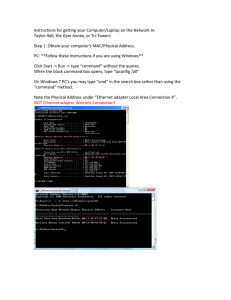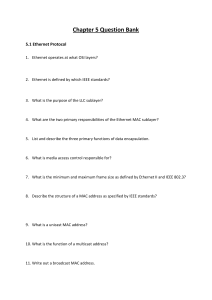
Chapter 5 Question Bank 5.1 Ethernet Protocol 1. Ethernet operates at what OSI layers? The Data Link layer and the Physical layer. 2. Ethernet is defined by which IEEE standards? They are defined in the IEEE 802.2 and 802.3 standards. 3. What is the purpose of the LLC sublayer? The Ethernet LLC sublayer handles the communication between the upper layers and the lower layers. This is typically between the networking software and the device hardware. The LLC sublayer takes the network protocol data, which is typically an IPv4 packet, and adds control information to help deliver the packet to the destination node. The LLC is used to communicate with the upper layers of the application, and transition the packet to the lower layers for delivery. 4. What are the two primary responsibilities of the Ethernet MAC sublayer? Data encapsulation Media access control 5. List and describe the three primary functions of data encapsulation. Frame delimiting - The framing process provides important delimiters that are used to identify a group of bits that make up a frame. These delimiting bits provide synchronization between the transmitting and receiving nodes. Addressing - The encapsulation process contains the Layer 3 PDU and also provides for data link layer addressing. Error detection - Each frame contains a trailer used to detect any errors in transmissions. 6. What is media access control responsible for? Media access control is responsible for the placement of frames on the media and the removal of frames from the media. As its name implies, it controls access to the media. This sublayer communicates directly with the physical layer. 7. What is the minimum and maximum frame size as defined by Ethernet II and IEEE 802.3? The ethernet IEEE 802.3 standard defines the minimum Ethernet frame size as 64 bytes, and the maximum frame size as 1518 bytes 8. Describe the structure of a MAC address as specified by IEEE standards? The IEEE assigns the vendor a 3-byte (24-bit) code, called the Organizationally Unique Identifier (OUI). All MAC addresses assigned to a NIC or other Ethernet device must use that vendor's assigned OUI as the first 3 bytes. All MAC addresses with the same OUI must be assigned a unique value in the last 3 bytes. 9. What is a unicast MAC address? A unicast MAC address is the unique address used when a frame is sent from a single transmitting device to a single destination device. 10. What is the function of a multicast address? Multicast addresses allow a source device to send a packet to a group of devices. Eg: distance learning through video conference, remote gaming 11. Write out a broadcast MAC address. 192.168.1.255 12. What command is used to identify the MAC address of an Ethernet adapter on a Windows host? ipconfig /all 13. What is the range of multiclass IPv4 addresses? The range of IPv4 multicast addresses is 224.0.0.0 to 239.255.255.255 5.2 LAN Switches 14. What type of address does an Ethernet Switch use to make forwarding decisions? A Layer 2 Ethernet switch uses MAC addresses to make forwarding decisions 15. How does a switch dynamically build up MAC address table? The switch dynamically builds the MAC address table by examining the source MAC address of the frames received on a port. The switch forwards frames by searching for a match between the destination MAC address in the frame and an entry in the MAC address table. 16. Explain what happens if the source MAC address does exist in the table but on a different port. If the source MAC address does exist in the table but on a different port, the switch treats this as a new entry. The entry is replaced using the same MAC address but with the more current port number. 17. If the destination IPv4 host is within the local network, the frame will use the MAC address of this device is used as the destination MAC address. For packets destined for external networks, which device’s MAC address would be used for the destination MAC address? 18. List and explain two forwarding methods for switching data between network ports. A store-and-forward switch receives the entire frame, and computes the CRC. If the CRC is valid, the switch looks up the destination address, which determines the outgoing interface. The frame is then forwarded out the correct port. A cut-through switch forwards the frame before it is entirely received. At a minimum, the destination address of the frame must be read before the frame can be forwarded. 19. List and explain two variants of cut-through switching. Fast-forward switching - Fast-forward switching offers the lowest level of latency. Fast-forward switching immediately forwards a packet after reading the destination address Because fast-forward switching starts forwarding before the entire packet has been received Fragment-free switching - In fragment-free switching, the switch stores the first 64 bytes of the frame before forwarding. Fragment-free switching tries to enhance fast-forward switching by performing a small error check on the first 64 bytes of the frame to ensure that a collision has not occurred before forwarding the frame. 20. An Ethernet switch may use a buffering technique to store frames before forwarding them, describe two memory buffering methods. Port-based Memory Buffering - In port-based memory buffering, frames are stored in queues that are linked to specific incoming and outgoing ports. A frame is transmitted to the outgoing port only when all the frames ahead of it in the queue have been successfully transmitted. Shared Memory Buffering - Shared memory buffering deposits all frames into a common memory buffer that all the ports on the switch share. The amount of buffer memory required by a port is dynamically allocated. The frames in the buffer are linked dynamically to the destination port. This allows the packet to be received on one port and then transmitted on another port, without moving it to a different queue. 21. What is duplex mismatch? Duplex mismatch occurs when one port on the link operates at half-duplex while the other port operates at full-duplex, also happens when the user reconfigure one side of the link and forgets to configure the other side 22. Explain in detail the function of the auto-MDIX feature. When the auto-MDIX feature is enabled, the switch detects the type of cable attached to the port, and configures the interfaces accordingly. Therefore, you can use either a crossover or a straight-through cable for connections to a copper 10/100/1000 port on the switch, regardless of the type of device on the other end of the connection. 5.3 Address Resolution Protocol 23. There are two primary addresses assigned to a device on an Ethernet LAN. List and describe both. a. Physical address (the MAC address) – Used for Ethernet NIC to Ethernet NIC communications on the same network. b. Logical address (the IP address) – Used to send the packet from the original source to the final destination. 24. The Layer 2 Ethernet frame contains: Destination MAC address – This is the MAC address of the file server’s Ethernet NIC. Source MAC address – This is the MAC address of PC-A’s Ethernet NIC. 25. The Layer 3 IP packet contains: Source IP address – This is the IP address of the original source, PC-A. Destination IP address – This is the IP address of the final destination, the file server. 26. When the destination IP address is in an external (or remote) network which device’s MAC address is used as the destination MAC address? When the destination IP address is on a remote network, the destination MAC address will be the address of the host’s default gateway 27. If the destination IP address is known but the destination MAC address is not known, how does a host determine what is the destination MAC address? If the device locates the IPv4 address, its corresponding MAC address is used as the destination MAC address in the frame. If there is no entry is found, then the device sends an ARP request. 28. What are the two basic function of ARP (Address Resolution Protocol)? Target IPv4 address – This is the IPv4 address that requires a corresponding MAC address. Target MAC address - This is the unknown MAC address and will be empty in the ARP request message. 29. What command is used to display the ARP table on a Cisco router or Switch? show ip arp 30. What command is used to display the ARP table on a Windows PC? arp - a 31. Explain how ARP spoofing or ARP poisoning works. This is a technique used by an attacker to reply to an ARP request for an IPv4 address belonging to another device, such as the default gateway, as shown in the figure. The attacker sends an ARP reply with its own MAC address. The receiver of the ARP reply will add the wrong MAC address to its ARP table and send these packets to the attacker.


